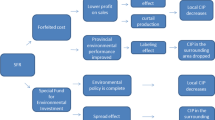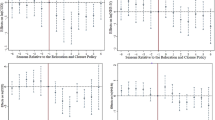Abstract
Industrial relocation and its environmental impact attract widespread attention. We incorporated environmental elements into the decision-making framework of industrial relocation and developed a mathematical economics model. With this model, we investigated the impact of environmental regulation on industrial relocation; we also compared the environmental impact after relocation with that before relocation. We found that regulation can affect relocation, but prerequisites exist. Some factors such as pollutant generation factor, pollutant treatment cost factor, and relocation cost are indispensable components of the prerequisites. We also found that impacts of regulation on relocations of pollution-intensive industries (PIIs) and clean industries are different, and pollutant generation factor and relocation cost are two critical factors leading to this difference. This result indicates that environmental regulation does not necessarily lead to a relocation of PIIs. Total amount and intensity of pollutant emissions increase after relocation, and the extent of increase is positively correlated with the regulation in the home country and negatively correlated with that in the host country. This result reveals that industrial relocation alleviates home country’s environmental pollution in the sacrifice of host country’s environment through emissions leakage. This research yields essential considerations in policy making of industrial relocation.

Source: UNCTAD (2016)

Source: YCELP (2019)








Source: World Bank (WB 2018). Unit: in million tonnes
Similar content being viewed by others
Notes
In the following, relocation is always referred as industrial relocation.
In the following, regulation is always referred as environmental regulation.
There are various forms of environmental regulation, including some command-and-control measures that affect pollutant treatment. Because these measures are hard to quantitatively incorporate into this model, we simplify the environmental regulation as pollutant emissions tax.
References
Aichele, R., & Felbermayr, G. (2015). Kyoto and carbon leakage: An empirical analysis of the carbon content of bilateral trade. Review of Economics and Statistics,97, 104–115.
Beladi, H., Chao, C.-C., & Frasca, R. (1999). Foreign investment and environmental regulations in LDCs. Resource and Energy Economics,21, 191–199.
Birdsall, N., & Wheeler, D. (1993). Trade policy and industrial pollution in Latin America: Where are the pollution havens? The Journal of Environment & Development,2, 137–149.
Brunnermeier, S. B., & Cohen, M. A. (2003). Determinants of environmental innovation in US manufacturing industries. Journal of Environmental Economics and Management,45, 278–293.
Cai, X., Lu, Y., Wu, M., & Yu, L. (2016). Does environmental regulation drive away inbound foreign direct investment? Evidence from a quasi-natural experiment in China. Journal of Development Economics,123, 73–85.
Celik, S., & Orbay, B. Z. (2011). Location choice under trade and environmental policies. Economic Modelling,28, 1710–1715.
Chung, S. (2014). Environmental regulation and foreign direct investment: Evidence from South Korea. Journal of Development Economics,108, 222–236.
Cole, M. A., & Elliott, R. J. (2005). FDI and the capital intensity of “dirty” sectors: A missing piece of the pollution haven puzzle. Review of Development Economics,9, 530–548.
Copeland, B. R., & Taylor, M. S. (2013). Trade and the environment: Theory and evidence. Princeton: Princeton University Press.
Dam, L., & Scholtens, B. (2008). Environmental regulation and MNEs location: Does CSR matter? Ecological Economics,67, 55–65.
Dam, L., & Scholtens, B. (2012). The curse of the haven: The impact of multinational enterprise on environmental regulation. Ecological Economics,78, 148–156.
de Castro, P. G., Fernandes, E. A., & Campos, A. C. (2013). The determinants of foreign direct investment in Brazil and Mexico: An empirical analysis. Procedia Economics and Finance,5, 231–240.
De Santis, R. A., & Stähler, F. (2009). Foreign direct investment and environmental taxes. German Economic Review,10, 115–135.
Dean, J. M., Lovely, M. E., & Wang, H. (2009). Are foreign investors attracted to weak environmental regulations? Evaluating the evidence from China. Journal of Development Economics,90, 1–13.
Deng, Y., & Xu, H. (2015). International direct investment and transboundary pollution: An empirical analysis of complex networks. Sustainability,7, 3933–3957.
Di, W. (2007). Pollution abatement cost savings and FDI inflows to polluting sectors in China. Environment and Development Economics,12, 775–798.
Duerksen, C., & Leonard, H. J. (1980). Environmental regulations and the location of industries: An international perspective. Columbia Journal of World Business,15, 52–58.
Dufour, C., Lanoie, P., & Patry, M. (1995). Regulation and productivity in the Quebec manufacturing sector. Montreal: CIRANO.
Elliott, R. J., & Zhou, Y. (2013). Environmental regulation induced foreign direct investment. Environmental & Resource Economics,55, 141–158.
Fell, H., & Maniloff, P. (2018). Leakage in regional environmental policy: The case of the regional greenhouse gas initiative. Journal of Environmental Economics and Management,87, 1–23.
Fredriksson, P. G., List, J. A., & Millimet, D. L. (2003). Bureaucratic corruption, environmental policy and inbound US FDI: Theory and evidence. Journal of Public Economics,87, 1407–1430.
Friedman, J., Gerlowski, D. A., & Silberman, J. (1992). What attracts foreign multinational corporations? Evidence from branch plant location in the United States. Journal of Regional Science,32, 403–418.
Hanna, R. (2010). US environmental regulation and FDI: Evidence from a panel of US-based multinational firms. American Economic Journal: Applied Economics,2, 158–189.
http://unctadstat.unctad.org/wds/TableViewer/tableView.aspx?ReportId=96740. (2016). http://unctadstat.unctad.org/wds/ReportFolders/reportFolders.aspx?sCS_ChosenLang=en.
https://data.worldbank.org/indicator. (2018).
Huang, J., Chen, X., Huang, B., & Yang, X. (2017). Economic and environmental impacts of foreign direct investment in China: A spatial spillover analysis. China Economic Review,45, 289–309.
Jadhav, P. (2012). Determinants of foreign direct investment in BRICS economies: Analysis of economic, institutional and political factor. Procedia-Social and Behavioral Sciences,37, 5–14.
Kamińska, T. (2016). Is the ‘flying geese’ paradigm useful to explain advancement in the European Union by means of FDI phenomenon? Journal of International Studies,9, 9–24.
Kellenberg, D. K. (2009). An empirical investigation of the pollution haven effect with strategic environment and trade policy. Journal of International Economics,78, 242–255.
Kheder, S. B., & Zugravu, N. (2012). Environmental regulation and French firms location abroad: An economic geography model in an international comparative study. Ecological Economics,77, 48–61.
Kim, M. H., & Adilov, N. (2012). The lesser of two evils: An empirical investigation of foreign direct investment-pollution tradeoff. Applied Economics,44, 2597–2606.
Lan, J., Kakinaka, M., & Huang, X. (2012). Foreign direct investment, human capital and environmental pollution in China. Environmental & Resource Economics,51, 255–275.
Lanoie, P., Patry, M., & Lajeunesse, R. (2008). Environmental regulation and productivity: Testing the porter hypothesis. Journal of Productivity Analysis,30, 121–128.
Lee, K.-D., Lee, W., & Kang, K. (2014). Pollution haven with technological externalities arising from foreign direct investment. Environmental & Resource Economics,57, 1–18.
Leiter, A. M., Parolini, A., & Winner, H. (2011). Environmental regulation and investment: Evidence from European industry data. Ecological Economics,70, 759–770.
Levinson, A. (1996). Environmental regulations and manufacturers’ location choices: Evidence from the Census of Manufactures. Journal of Public Economics,62, 5–29.
Li, M., & Wang, Q. (2017). Will technology advances alleviate climate change? Dual effects of technology change on aggregate carbon dioxide emissions. Energy for Sustainable Development,41, 61–68.
Lian, T., Ma, T., Cao, J., & Wu, Y. (2016). The effects of environmental regulation on the industrial location of China’s manufacturing. Natural Hazards,80, 1381–1403.
Lin, J., et al. (2014). China’s international trade and air pollution in the United States. Proceedings of the National Academy of Sciences,111, 1736–1741.
List, J. A., & Co, C. Y. (2000). The effects of environmental regulations on foreign direct investment. Journal of Environmental Economics and Management,40, 1–20.
List, J. A., McHone, W. W., & Millimet, D. L. (2003). Effects of air quality regulation on the destination choice of relocating plants. Oxford Economic Papers,55, 657–678.
Ljungwall, C., & Linde-Rahr, M. (2005). Environmental policy and the location of foreign direct investment in China. East Asian Bureau of Economic Research, Governance Working Papers.
Low, P., & Yeats, A. (1992). Do ‘dirty’ industries migrate? In P. Low (Ed.), International trade and the environment. World Bank Discussion Paper, 159
McGuire, M. C. (1982). Regulation, factor rewards, and international trade. Journal of Public Economics,17, 335–354.
McQuaid, R. W., Leitham, S., & Nelson, J. D. (1996). Accessibility and location decisions in a peripheral region of Europe: A logit analysis. Regional Studies,30, 579–588.
Millimet, D. L., & Roy, J. (2016). Empirical tests of the pollution haven hypothesis when environmental regulation is endogenous. Journal of Applied Econometrics,31, 652–677.
Mulatu, A. (2017). The structure of UK outbound FDI and environmental regulation. Environmental and Resource Economics,68, 1–32.
Munday, M. (1990). Japanese manufacturing investment in Wales. Cardiff: University of Wales Press.
Naughton, H. T. (2014). To shut down or to shift: Multinationals and environmental regulation. Ecological Economics,102, 113–117.
Oh, H.-R., et al. (2015). Long-range transport of air pollutants originating in China: A possible major cause of multi-day high-PM10 episodes during cold season in Seoul, Korea. Atmospheric Environment,109, 23–30.
Saikawa, E., & Urpelainen, J. (2014). Environmental standards as a strategy of international technology transfer. Environmental Science & Policy,38, 192–206.
Shadbegian, R. J., & Gray, W. B. (2005). Pollution abatement expenditures and plant-level productivity: A production function approach. Ecological Economics,54, 196–208.
Shen, J., Wei, Y. D., & Yang, Z. (2017). The impact of environmental regulations on the location of pollution-intensive industries in China. Journal of Cleaner Production,148, 785–794.
Sun, Q., Tong, W., & Yu, Q. (2002). Determinants of foreign direct investment across China. Journal of International Money and Finance,21, 79–113.
Tobey, J. A. (1990). The effects of domestic environmental policies on patterns of world trade: An empirical test. Kyklos,43, 191–209.
Wagner, U. J., & Timmins, C. D. (2009). Agglomeration effects in foreign direct investment and the pollution haven hypothesis. Environmental & Resource Economics,43, 231–256.
Waldkirch, A., & Gopinath, M. (2008). Pollution control and foreign direct investment in Mexico: An industry-level analysis. Environmental & Resource Economics,41, 289–313.
Walter, I. (1978). Environmental attitudes in less developed countries. Resources Policy,4, 200–204.
Wu, H., Guo, H., Zhang, B., & Bu, M. (2017). Westward movement of new polluting firms in China: Pollution reduction mandates and location choice. Journal of Comparative Economics,45, 119–138.
Wu, A., Li, G., Sun, T., & Liang, Y. (2014). Effects of industrial relocation on Chinese regional economic growth disparities: Based on system dynamics modeling. Chinese Geographical Science,24, 706–716.
Xing, Y., & Kolstad, C. D. (2002). Do lax environmental regulations attract foreign investment? Environmental & Resource Economics,21, 1–22.
YCELP. (2019). Environmental Performance Index (EPI). https://epi.envirocenter.yale.edu. Accessed 30 May 2019.
Zeng, D.-Z., & Zhao, L. (2009). Pollution havens and industrial agglomeration. Journal of Environmental Economics and Management,58, 141–153.
Zheng, D., & Shi, M. (2017). Multiple environmental policies and pollution haven hypothesis: Evidence from China’s polluting industries. Journal of Cleaner Production,141, 295–304.
Author information
Authors and Affiliations
Corresponding author
Additional information
Publisher's Note
Springer Nature remains neutral with regard to jurisdictional claims in published maps and institutional affiliations.
Electronic supplementary material
Below is the link to the electronic supplementary material.
Rights and permissions
About this article
Cite this article
Li, M., Wang, Q. Does industrial relocation alleviate environmental pollution? A mathematical economics analysis. Environ Dev Sustain 22, 4673–4698 (2020). https://doi.org/10.1007/s10668-019-00403-7
Received:
Accepted:
Published:
Issue Date:
DOI: https://doi.org/10.1007/s10668-019-00403-7




